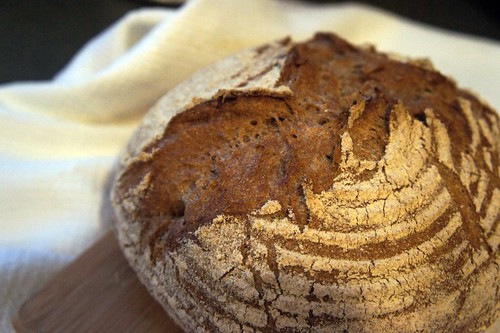After no fewer than 60 loaves and as many methodologies, I finally pulled a nearly perfect loaf of a simple organic bread from my cheap pseudo-commercial oven. A combination of methods, it's largely based on the Sullivan Street Bakery's (www.sullivanstreetbakery.com) no-knead recipe first popularized by the NYT (despite my stubborn initial refusal to embrace the simplicity of that approach).
My desire to make bread from high-quality, but very simple ingredients, started this madness. It's hard to resist something so exquisite made solely from salt, water, yeast and flour.
The shortcomings of a pure Sullivan Street-style "no-knead" bread are: while passed off as "rustic" in appearance, the loaves are a bit sloppy, the attempt to make this method accessible creates some variation in result and the finished loaf lacks the "yeasty" smell and flavor of great artisan bread.
A generously floured round willow proofing basket, to my mind, yields a better-looking loaf. The regular concentric dusting circles, and light ridges, reft by irregular rising cracks are worth the extra effort. So, rather than all the dusted dishtowels Jim Lahey recommends, I just shape the dough and toss it into a dusted proofing basket.
I get highly consistent results simply by experimenting to find the best ingredients and working out careful weight measures. I've settled on Great River Organic Stone-Ground Bread Flour greatrivermilling.com/downloads/Organic_Bread_Flours_Great_River.pdf), Smart Water (good pH balance for the yeast), Fleur de Mer grey sea salt and a combination of cake yeast/Red Star active yeast. The liquids add up to 1-2/3 cups (rather than 1-5/8 cups) to 450g (rather than 3 cups) of flour.
I've bumped up the bread flavor by borrowing from the sourdough and "pain sur poolish" techniques. I start by mixing 8g of cake yeast with 3 Tbs of warm Smart Water and adding about a tsp of organic clover honey (agh, cheating...but it's worth it). I put this aside for some hours until the yeast activity subsides and the mixture has a strong fermented smell. I throw this mixture in a measuring cup, which I then top up with more Smart Water to reach the 1-2/3 cups of liquid required for my version of the recipe.
Overall, this produces an attractive, flavorful loaf, with all of the user-friendliness of the Sullivan Street revolution and without its shortcomings.
Sunday, December 12, 2010
Homemade Organic Boule
Posted by
Unknown
at
10:27 AM
![]()
Subscribe to:
Post Comments (Atom)


 Afro D' Mercedes - Addy Mercedes
Afro D' Mercedes - Addy Mercedes Children's Corner - Claude Debussy (play on iMeem)
Children's Corner - Claude Debussy (play on iMeem) Cosmic Slop - Funkadelic
Cosmic Slop - Funkadelic
No comments:
Post a Comment